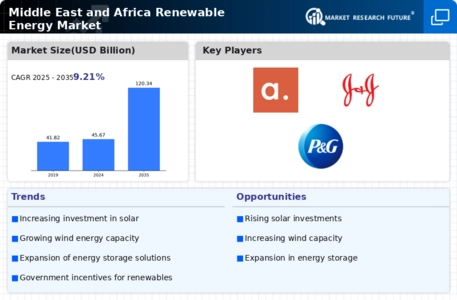The Middle East and Africa Renewable Energy Market is currently characterized by a dynamic competitive landscape, driven by a confluence of factors including government policies, technological advancements, and increasing demand for sustainable energy solutions. Key players such as ACWA Power (SA), Masdar (AE), and Engie (FR) are strategically positioned to leverage these growth drivers. ACWA Power (SA) focuses on large-scale renewable projects, particularly in solar and wind energy, while Masdar (AE) emphasizes innovation in clean technology and sustainable urban development. Engie (FR), on the other hand, is expanding its portfolio through strategic partnerships and acquisitions, thereby enhancing its operational footprint in the region. Collectively, these strategies not only bolster their competitive positioning but also contribute to a more integrated and resilient market structure.
In terms of business tactics, companies are increasingly localizing manufacturing and optimizing supply chains to enhance operational efficiency. The market appears moderately fragmented, with a mix of established players and emerging companies vying for market share. This competitive structure allows for diverse approaches to renewable energy solutions, fostering innovation and collaboration among key players. The collective influence of these companies is shaping a landscape where agility and responsiveness to market demands are paramount.
In August 2025, ACWA Power (SA) announced the commissioning of a 1.5 GW solar power plant in Saudi Arabia, marking a significant milestone in its expansion strategy. This project not only reinforces ACWA Power's commitment to renewable energy but also positions it as a leader in the region's transition towards sustainable energy sources. The strategic importance of this development lies in its potential to significantly reduce carbon emissions and enhance energy security in the Kingdom.
In September 2025, Masdar (AE) unveiled a partnership with a local government in Egypt to develop a 500 MW wind farm. This collaboration underscores Masdar's focus on regional expansion and its commitment to harnessing local resources for renewable energy generation. The strategic implications of this partnership are profound, as it not only diversifies Masdar's portfolio but also strengthens its presence in a rapidly growing market.
In October 2025, Engie (FR) completed the acquisition of a minority stake in a renewable energy startup in South Africa, aimed at enhancing its technological capabilities in solar energy. This move reflects Engie's strategy to integrate innovative solutions into its operations, thereby positioning itself at the forefront of the renewable energy sector. The acquisition is likely to facilitate knowledge transfer and accelerate the development of cutting-edge technologies in the region.
As of October 2025, the competitive trends in the renewable energy market are increasingly defined by digitalization, sustainability, and the integration of artificial intelligence. Strategic alliances are becoming more prevalent, as companies recognize the value of collaboration in driving innovation and enhancing operational efficiency. Looking ahead, competitive differentiation is expected to evolve, with a shift from traditional price-based competition towards a focus on technological innovation, reliability in supply chains, and sustainable practices. This transition may redefine the competitive landscape, compelling companies to adapt and innovate continuously.














Leave a Comment